A Three-Phase Dynamic Wireless Charging System with Constant Output Voltage
Abstract
:1. Introduction
2. Design and Optimization of Coil Structure
3. Circuit Analysis
4. Experimental Verification
5. Conclusions
Acknowledgments
Author Contributions
Conflicts of Interest
References
- Yilmaz, M.; Krein, P.T. Review of Battery Charger Topologies, Charging Power Levels, and Infrastructure for Plug-in Electric and Hybrid Vehicles. IEEE Trans. Power Electron. 2013, 28, 2151–2169. [Google Scholar] [CrossRef]
- Li, Y.; Mai, R.; Lin, T.; Sun, H.; He, Z. A Novel WPT System Based on Dual Transmitters and Dual Receivers for High Power Applications: Analysis, Design and Implementation. Energies 2017, 10, 174. [Google Scholar] [CrossRef]
- Aditya, K.; Williamson, S. Linearization and Control of Series-Series Compensated Inductive Power Transfer System Based on Extended Describing Function Concept. Energies 2016, 9, 962. [Google Scholar] [CrossRef]
- Keeling, N.A.; Covic, G.A.; Boys, J.T. A Unity-Power-Factor IPT Pickup for High-Power Applications. IEEE Trans. Ind. Electron. 2010, 57, 744–751. [Google Scholar] [CrossRef]
- Qiang, H.; Huang, X.; Tan, L.; Ji, Q.; Zhao, J. Achieving Maximum Power Transfer of Inductively Coupled Wireless Power Transfer System Based on Dynamic Tuning Control. Sci. China Technol. Sci. 2012, 55, 1886–1893. [Google Scholar] [CrossRef]
- Xue, R.; Cheng, K.; Je, M. High-Efficiency Wireless Power Transfer for Biomedical Implants by Optimal Resonant Load Transformation. IEEE Trans. Circuits Syst. I Regul. Pap. 2013, 60, 867–874. [Google Scholar] [CrossRef]
- Wu, H.H.; Gilchrist, A.; Sealy, K.D.; Bronson, D. A High Efficiency 5 kW Inductive Charger for EVs Using Dual Side Control. IEEE Trans. Ind. Inform. 2012, 8, 585–595. [Google Scholar] [CrossRef]
- Deng, J.; Lu, F.; Li, W.; Ma, R.; Mi, C. Zvs Double-Side LCC Compensated Resonant Inverter with Magnetic Integration for Electric Vehicle Wireless Charger. In Proceedings of the 2015 IEEE Applied Power Electronics Conference and Exposition (APEC), Charlotte, NC, USA, 15–19 March 2015; pp. 1131–1136. [Google Scholar]
- Buchmann, I. Fast and Ultra-Fast Chargers, 2017. Fast and Ultra-Fast Chargers—Battery University. Available online: http://batteryuniversity.com/learn/article/ultra_fast_chargers (accessed on 6 November 2017).
- Levitan, D. For Electric Car Batteries, the Race for a Rapid Charge, 2012. For Electric Car Batteries, the Race for a Rapid Charge—Yale E360. Available online: http://e360.yale.edu/features/for_electric_car_batteries__the_race_for_a_rapid_charge (accessed on 6 November 2017).
- Lee, W.Y.; Huh, J.; Choi, S.Y.; Thai, X.V.; Kim, J.H.; Al-Ammar, E.A.; El-Kady, M.A.; Rim, C.T. Finite-Width Magnetic Mirror Models of Mono and Dual Coils for Wireless Electric Vehicles. IEEE Trans. Power Electron. 2013, 28, 1413–1428. [Google Scholar] [CrossRef]
- Ko, Y.D.; Jang, Y.J. The Optimal System Design of the Online Electric Vehicle Utilizing Wireless Power Transmission Technology. IEEE Trans. Intell. Transp. Syst. 2013, 14, 1255–1265. [Google Scholar] [CrossRef]
- Jang, Y.J.; Suh, E.S.; Kim, J.W. System Architecture and Mathematical Models of Electric Transit Bus System Utilizing Wireless Power Transfer Technology. IEEE Syst. J. 2016, 10, 495–506. [Google Scholar] [CrossRef]
- Huh, J.; Lee, S.W.; Lee, W.Y.; Cho, G.H.; Rim, C.T. Narrow-Width Inductive Power Transfer System for Online Electrical Vehicles. IEEE Trans. Power Electron. 2011, 26, 3666–3679. [Google Scholar] [CrossRef]
- Onar, O.C.; Miller, J.M.; Campbell, S.L.; Coomer, C.; White, C.P.; Seiber, L.E. A Novel Wireless Power Transfer for in-Motion EV/PHEV Charging. In Proceedings of the 2013 Twenty-Eighth Annual IEEE Applied Power Electronics Conference and Exposition (APEC), Long Beach, CA, USA, 17–21 March 2013; pp. 3073–3080. [Google Scholar]
- Miller, J.M.; Jones, P.T.; Li, J.; Onar, O.C. Ornl Experience and Challenges Facing Dynamic Wireless Power Charging of EV’s. IEEE Circuits Syst. Mag. 2015, 15, 40–53. [Google Scholar] [CrossRef]
- Lee, K.; Pantic, Z.; Lukic, S.M. Reflexive Field Containment in Dynamic Inductive Power Transfer Systems. IEEE Trans. Power Electron. 2014, 29, 4592–4602. [Google Scholar] [CrossRef]
- Zhao, J.; Cai, T.; Duan, S.; Feng, H.; Chen, C.; Zhang, X. A General Design Method of Primary Compensation Network for Dynamic WPT System Maintaining Stable Transmission Power. IEEE Trans. Power Electron. 2016, 31, 8343–8358. [Google Scholar] [CrossRef]
- Miller, J.M.; Onar, O.C.; White, C.; Campbell, S.; Coomer, C.; Seiber, L.; Sepe, R.; Steyerl, A. Demonstrating Dynamic Wireless Charging of an Electric Vehicle: The Benefit of Electrochemical Capacitor Smoothing. IEEE Power Electron. Mag. 2014, 1, 12–24. [Google Scholar] [CrossRef]
- Covic, G.A.; Boys, J.T.; Kissin, M.L.G.; Lu, H.G. A Three-Phase Inductive Power Transfer System for Roadway-Powered Vehicles. IEEE Trans. Ind. Electron. 2007, 54, 3370–3378. [Google Scholar] [CrossRef]
- Pacini, A.; Mastri, F.; Trevisan, R.; Masotti, D.; Costanzo, A. Geometry Optimization of Sliding Inductive Links for Position-Independent Wireless Power Transfer. In Proceedings of the 2016 IEEE MTT-S International Microwave Symposium (IMS), San Francisco, CA, USA, 22–27 May 2016; pp. 1–4. [Google Scholar]
- Mou, X.; Groling, O.; Sun, H. Energy-Efficient and Adaptive Design for Wireless Power Transfer in Electric Vehicles. IEEE Trans. Ind. Electron. 2017, 64, 7250–7260. [Google Scholar] [CrossRef]
- Zhang, Z.; Chau, K.T. Homogeneous Wireless Power Transfer for Move-and-Charge. IEEE Trans. Power Electron. 2015, 30, 6213–6220. [Google Scholar] [CrossRef]
- Zhu, Q.; Wang, L.; Guo, Y.; Liao, C.; Li, F. Applying LCC Compensation Network to Dynamic Wireless EV Charging System. IEEE Trans. Ind. Electron. 2016, 63, 6557–6567. [Google Scholar] [CrossRef]
- Lu, F.; Zhang, H.; Hofmann, H.; Mi, C.C. A Dynamic Charging System with Reduced Output Power Pulsation for Electric Vehicles. IEEE Trans. Ind. Electron. 2016, 63, 6580–6590. [Google Scholar] [CrossRef]
- Boys, J.T.; Covic, G.A. The Inductive Power Transfer Story at the University of Auckland. IEEE Circuits Syst. Mag. 2015, 15, 6–27. [Google Scholar] [CrossRef]
- Erickson, R.W.; Maksimovic, D. Fundamentals of Power Electronics; Springer: Berlin, Germany, 2001. [Google Scholar]
- Park, C.; Lee, S.; Jeong, S.Y.; Cho, G.; Rim, C.T. Uniform Power I-Type Inductive Power Transfer System with DQ-Power Supply Rails for On-Line Electric Vehicles. IEEE Trans. Ind. Electron. 2015, 30, 6446–6455. [Google Scholar] [CrossRef]
- Zhou, S.; Chris Mi, C. Multi-Paralleled LCC Reactive Power Compensation Networks and their Tuning Method for Electric Vehicle Dynamic Wireless Charging. IEEE Trans. Ind. Electron. 2016, 63, 6546–6556. [Google Scholar] [CrossRef]
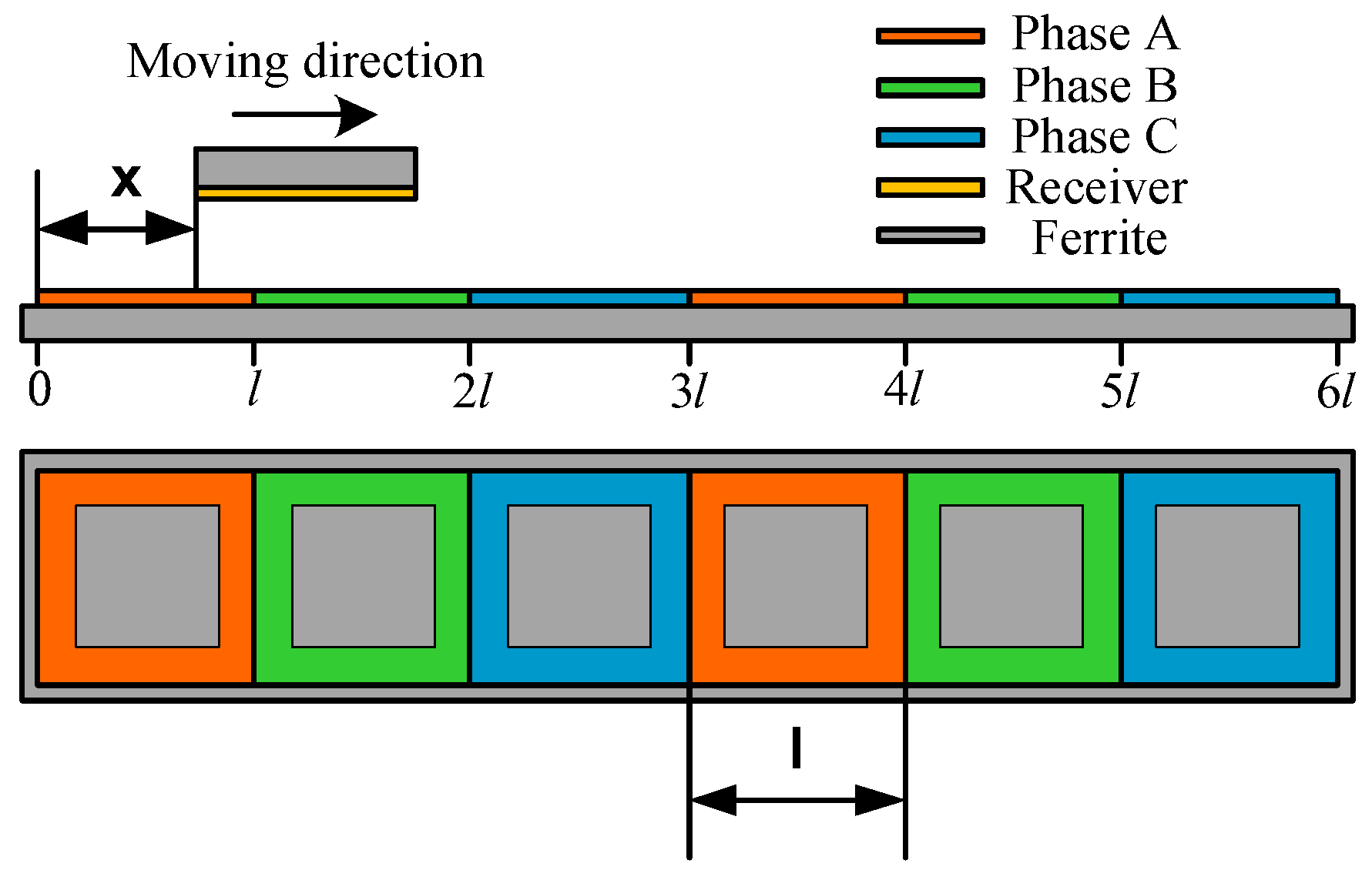
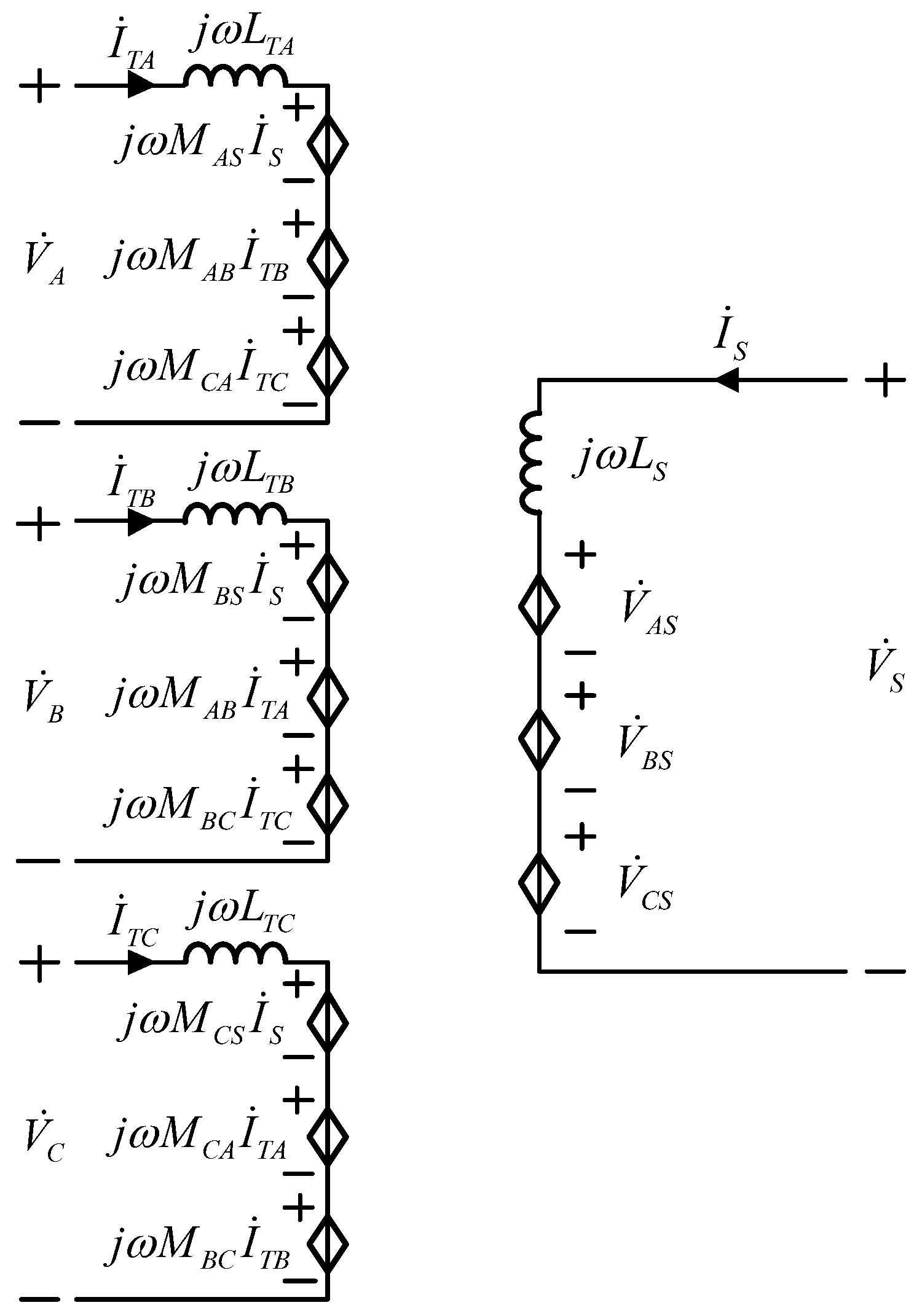
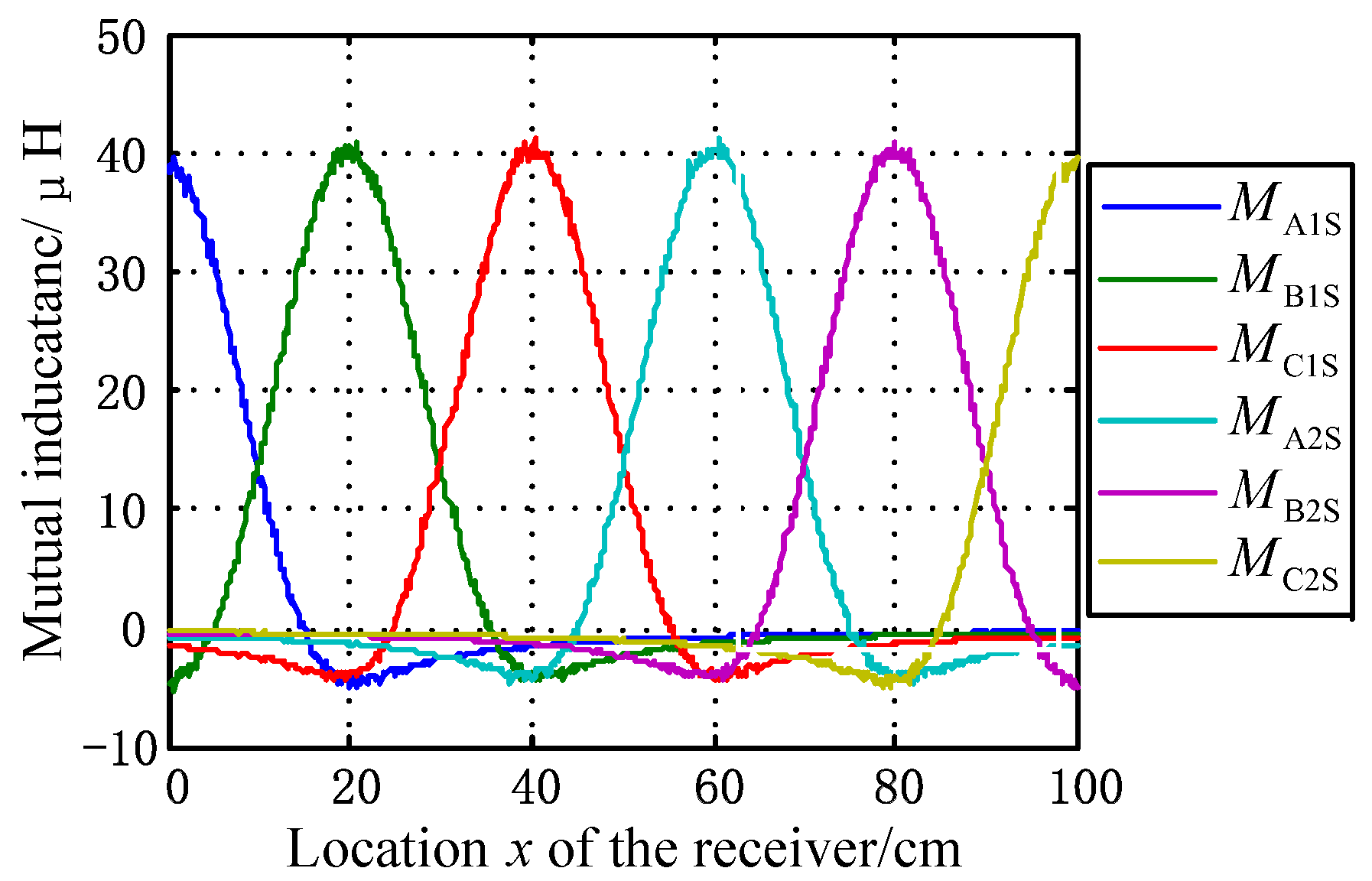
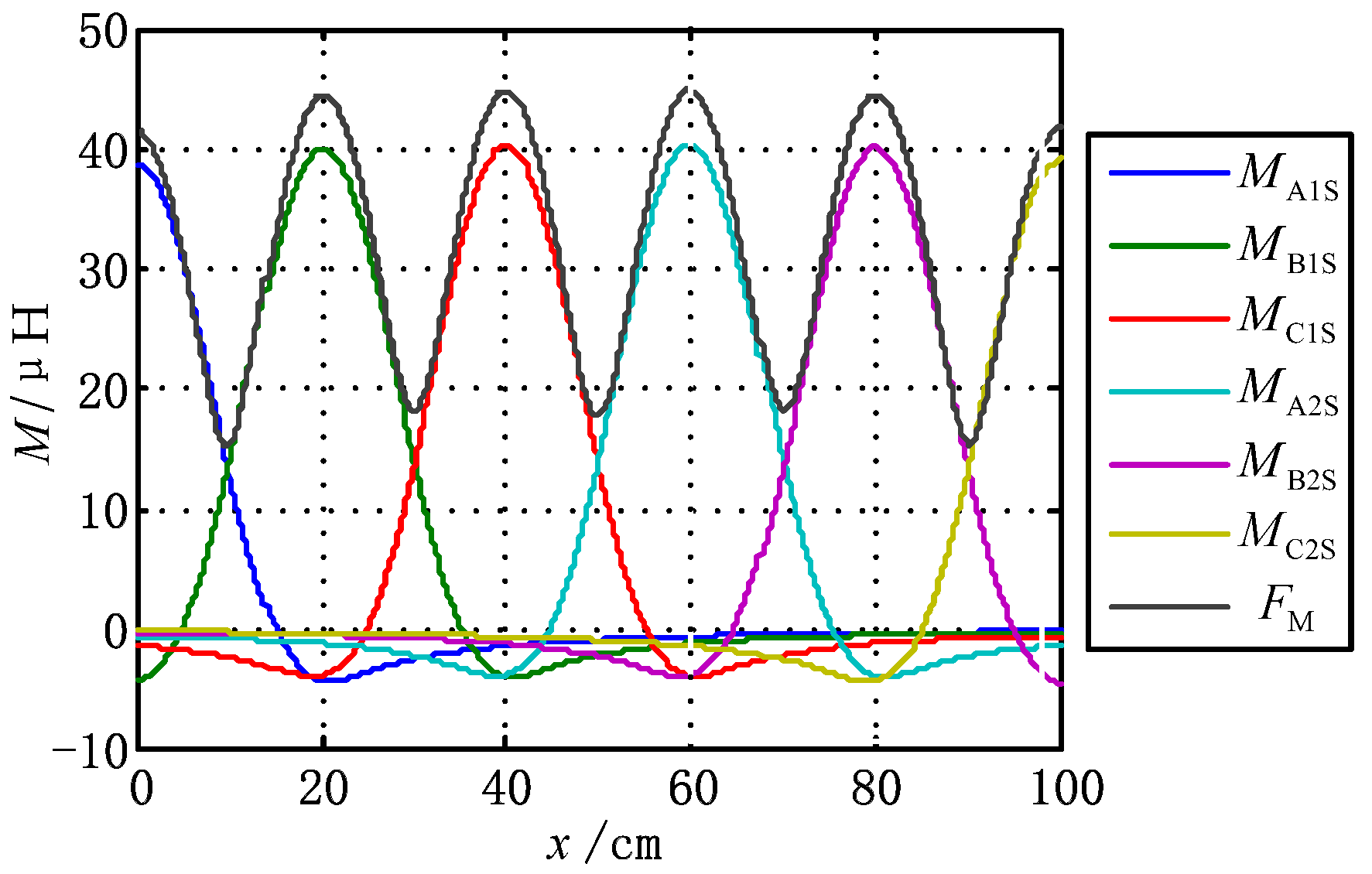

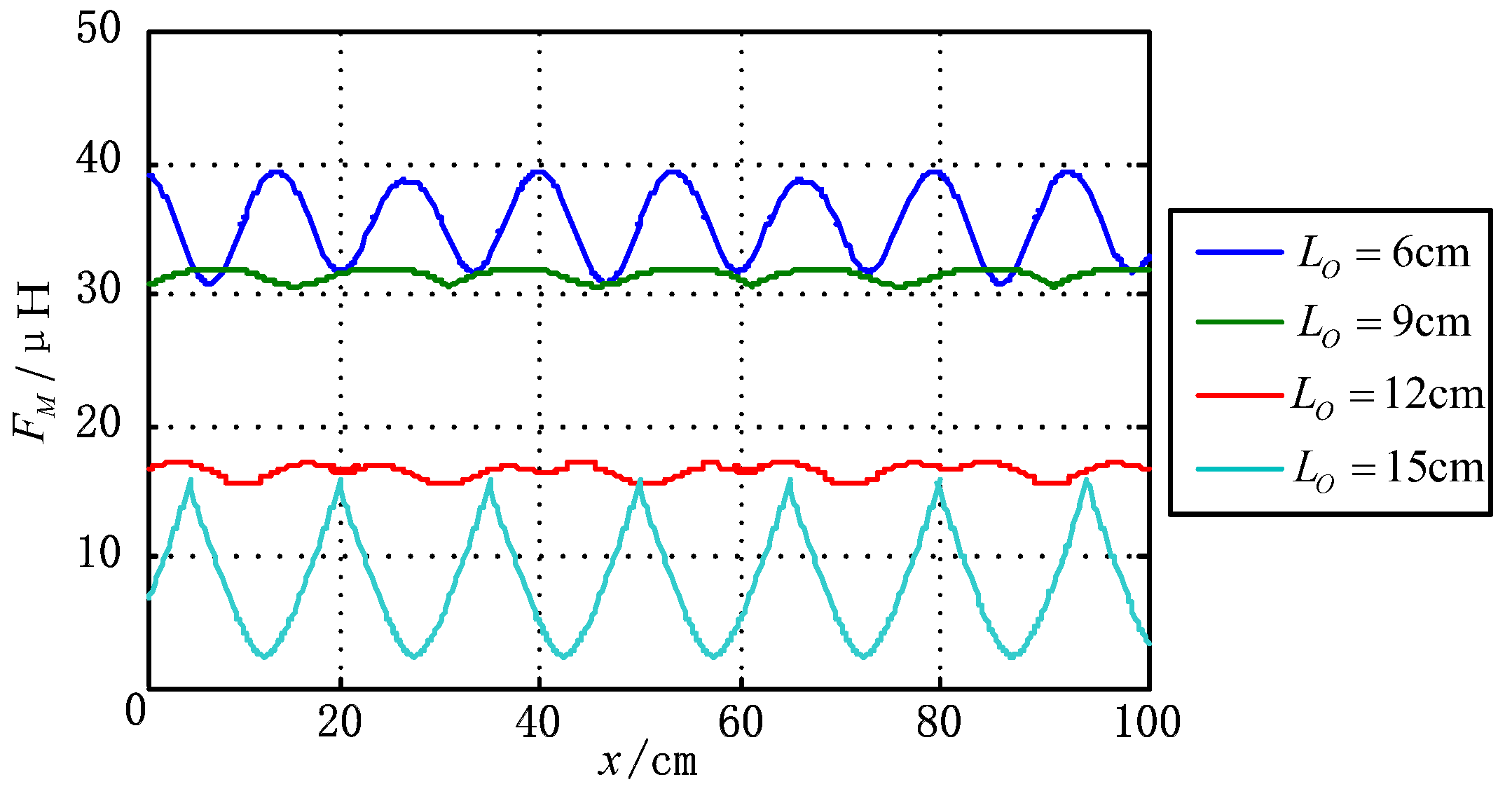
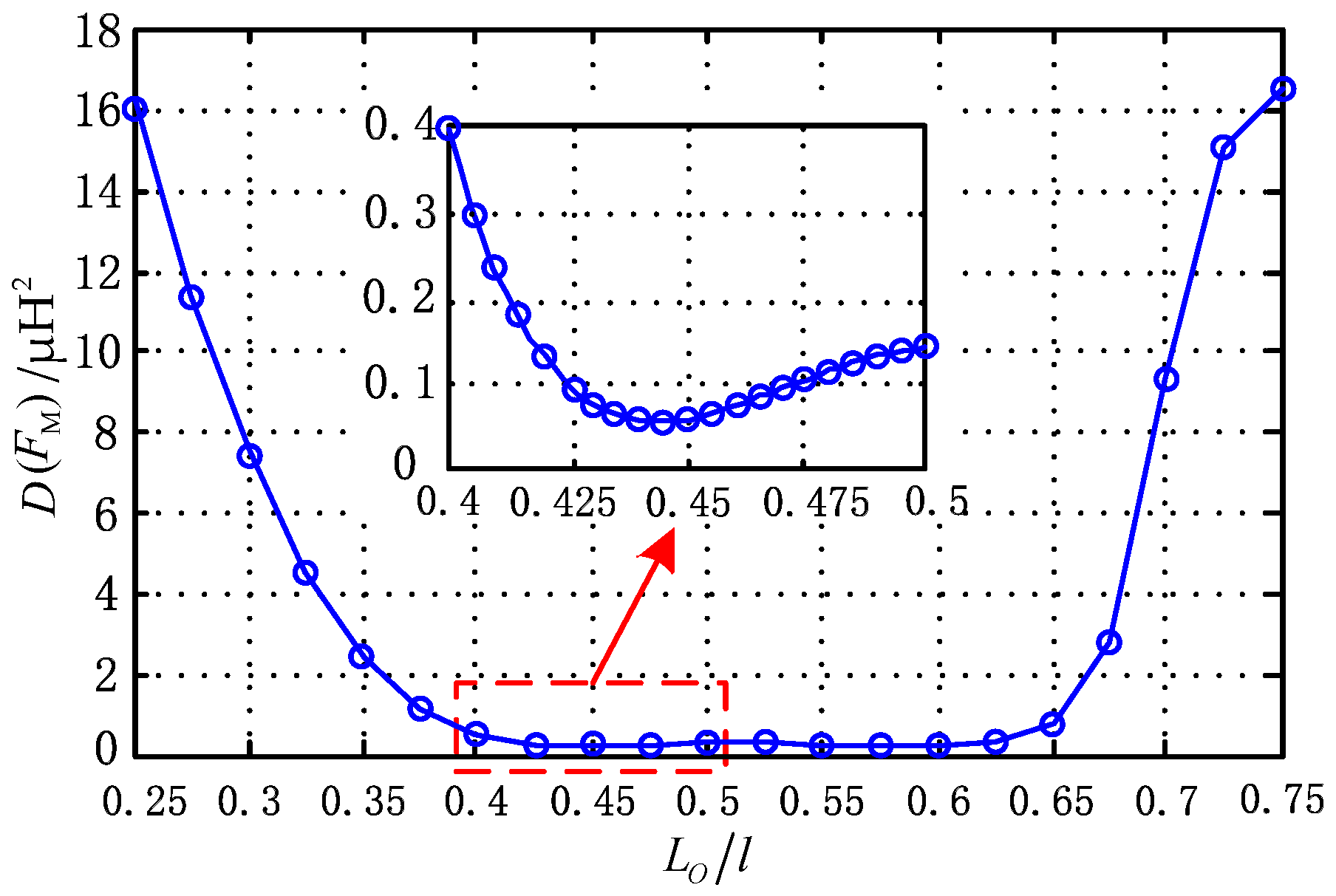
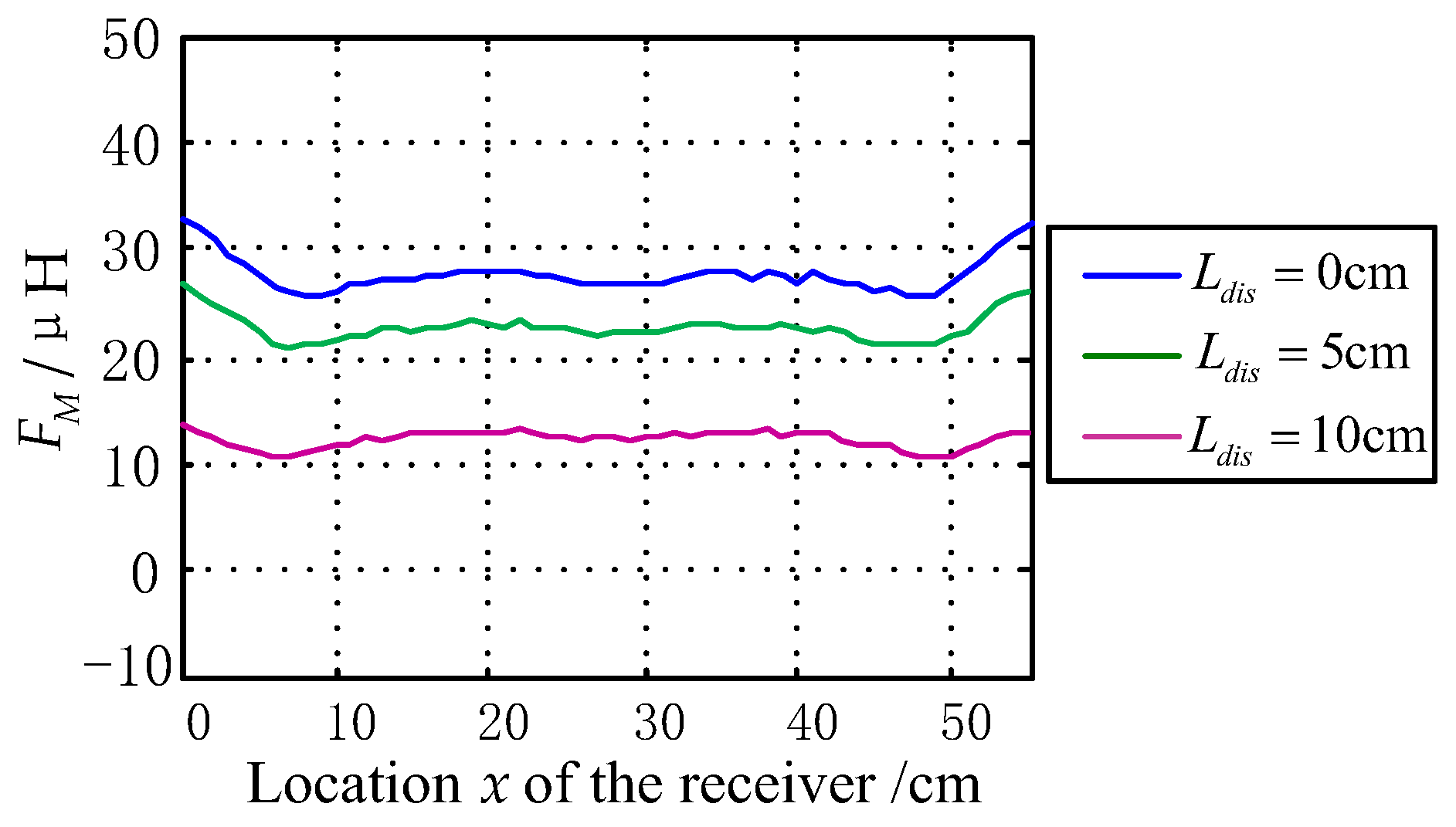

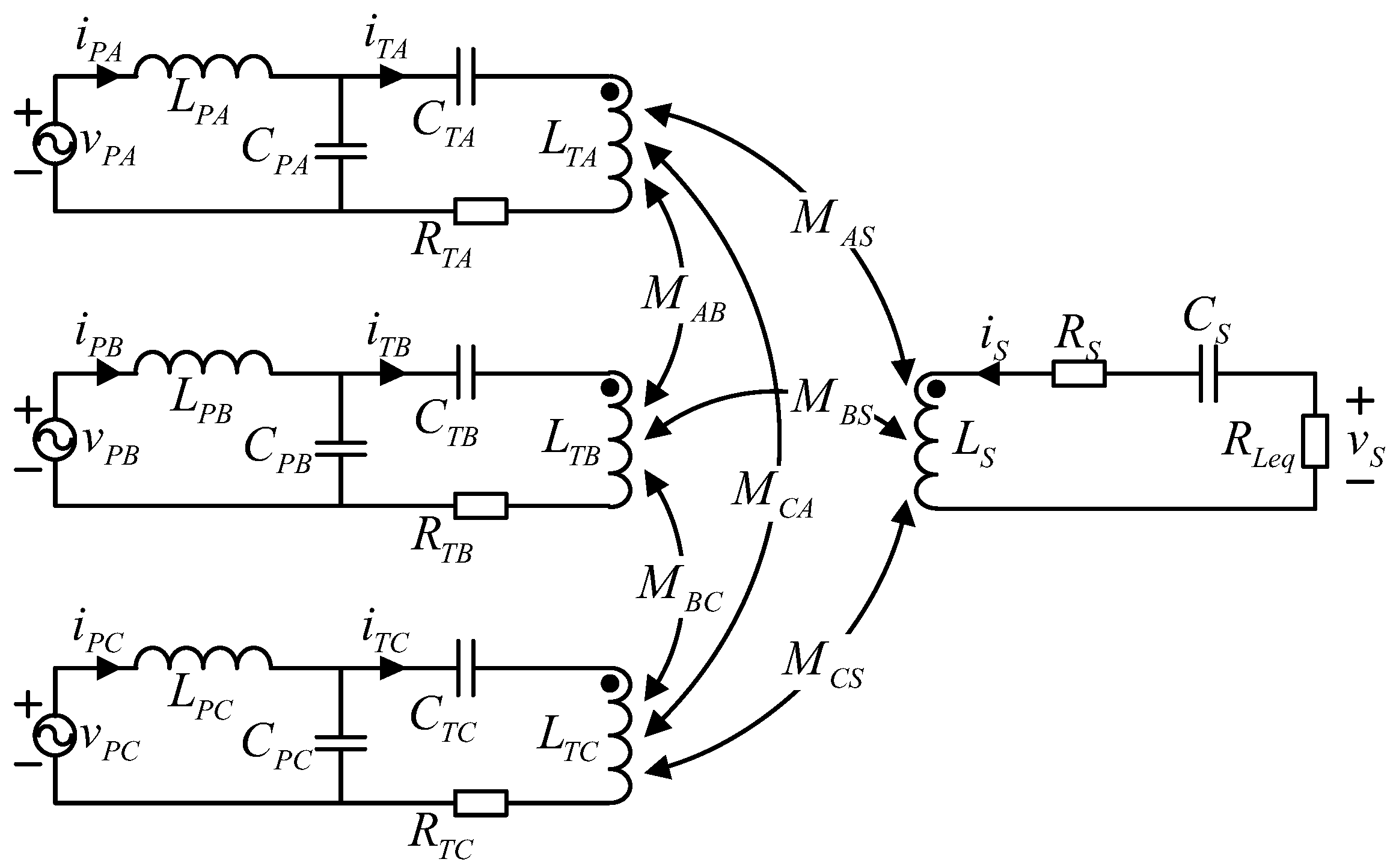
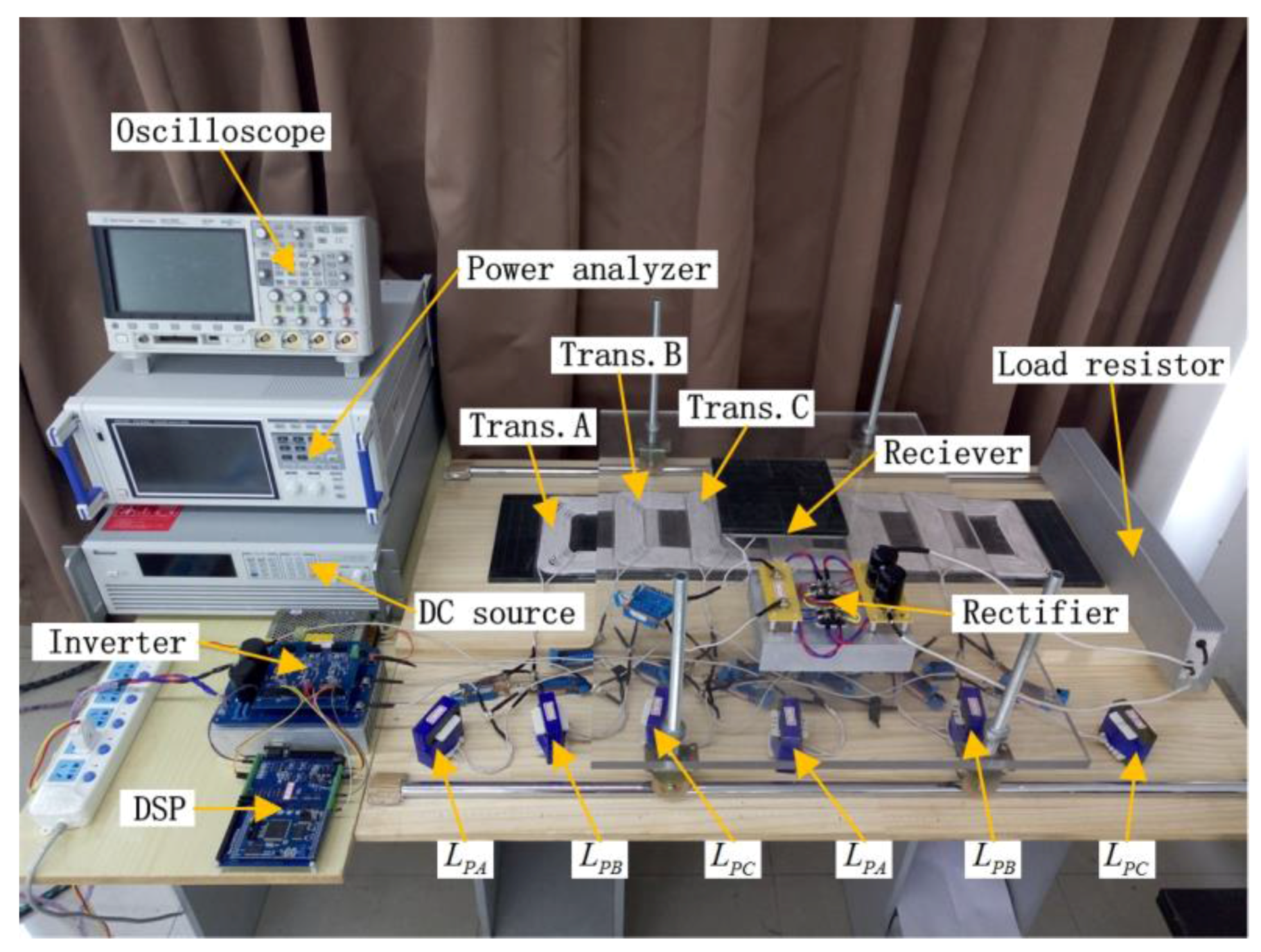
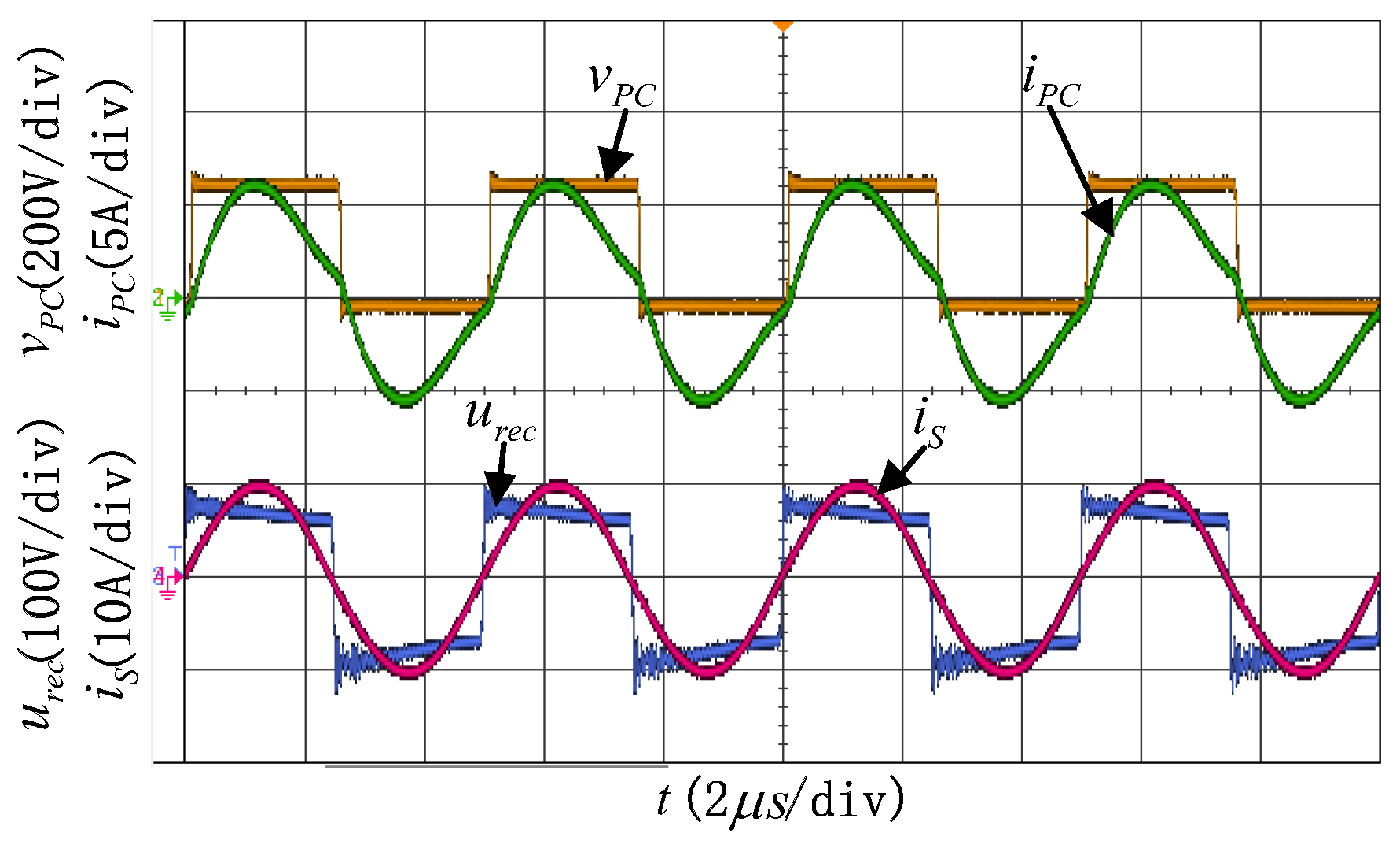

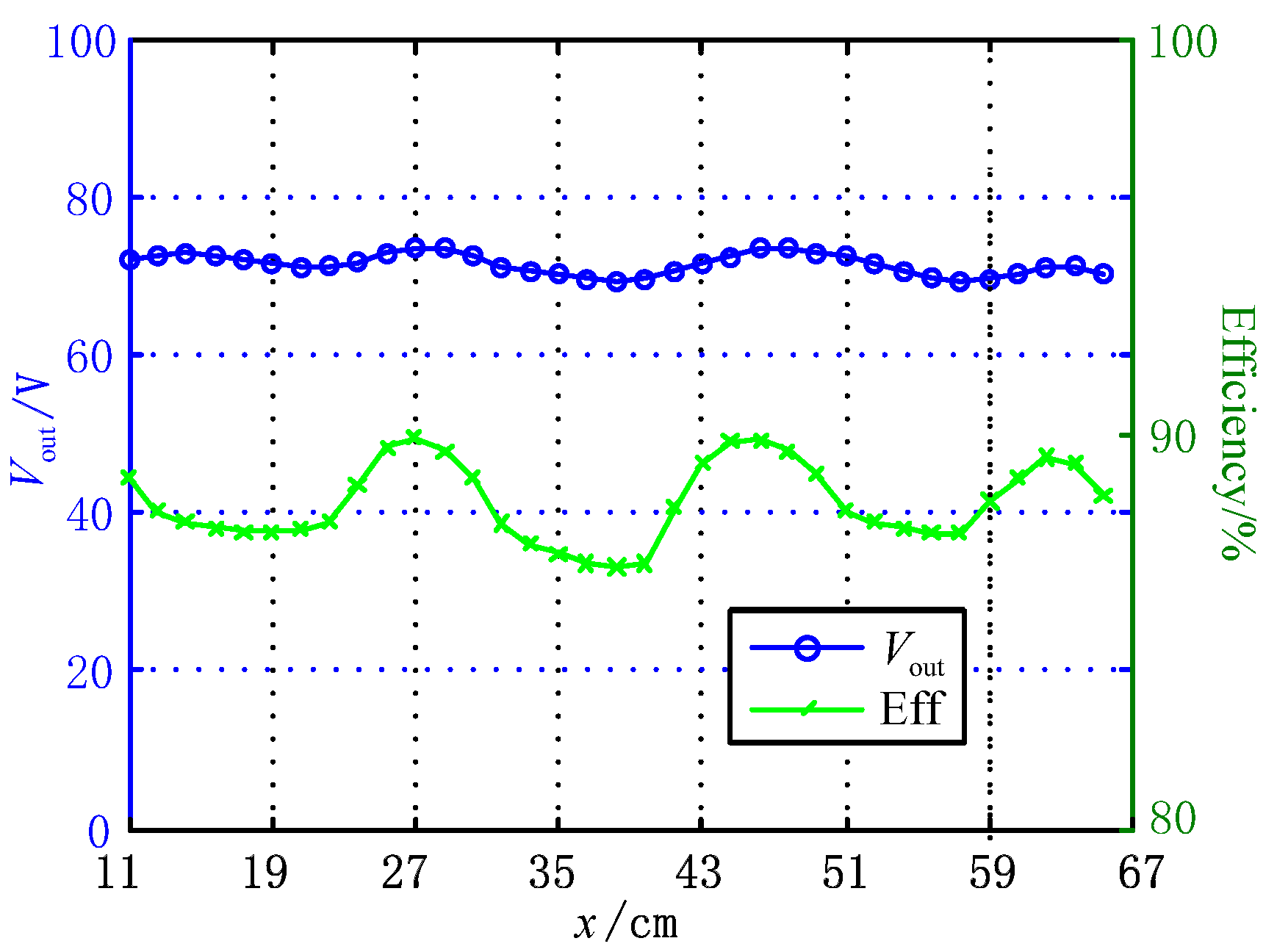
| Parameters | Value |
|---|---|
| Length of a Q coil [26] /mm | 200 |
| Air gap distance /mm | 70 |
| Q coil turns in transmitter A | 17 |
| Q coil turns in transmitter B | 17 |
| Q coil turns in transmitter C | 17 |
| Q coil turns in receiver | 17 |
| Relative position /mm | [0,1200] |
| Parameters | Value | Parameters | Value |
|---|---|---|---|
| /kHz | 200 | /Ω | 0.15 |
| /V | 315 | /μH | 50.29 |
| /V | 72 | /nF | 12.94 |
| /cm | 8.9 | /μH | 119.47 |
| /μH | 50.39 | /nF | 15.32 |
| /nF | 12.36 | /Ω | 0.1 |
| /μH | 120.1 | /μH | 110.53 |
| /nF | 14.98 | /nF | 5.96 |
| /Ω | 0.1 | /Ω | 0.18 |
| /μH | 49.6 | Maximum value of /μH | 37.68 |
| /nF | 13.73 | Maximum value of /μH | 38.1 |
| /μH | 122.8 | Maximum value of /μH | 38.55 |
| /nF | 13.95 | Output capacitor /μF | 940 |
© 2018 by the authors. Licensee MDPI, Basel, Switzerland. This article is an open access article distributed under the terms and conditions of the Creative Commons Attribution (CC BY) license (http://creativecommons.org/licenses/by/4.0/).
Share and Cite
Mai, R.; Li, H.; Liu, Y.; Zhou, K.; Fu, L.; He, Z. A Three-Phase Dynamic Wireless Charging System with Constant Output Voltage. Energies 2018, 11, 45. https://doi.org/10.3390/en11010045
Mai R, Li H, Liu Y, Zhou K, Fu L, He Z. A Three-Phase Dynamic Wireless Charging System with Constant Output Voltage. Energies. 2018; 11(1):45. https://doi.org/10.3390/en11010045
Chicago/Turabian StyleMai, Ruikun, Hongchao Li, Yeran Liu, Kunzhuo Zhou, Ling Fu, and Zhengyou He. 2018. "A Three-Phase Dynamic Wireless Charging System with Constant Output Voltage" Energies 11, no. 1: 45. https://doi.org/10.3390/en11010045





